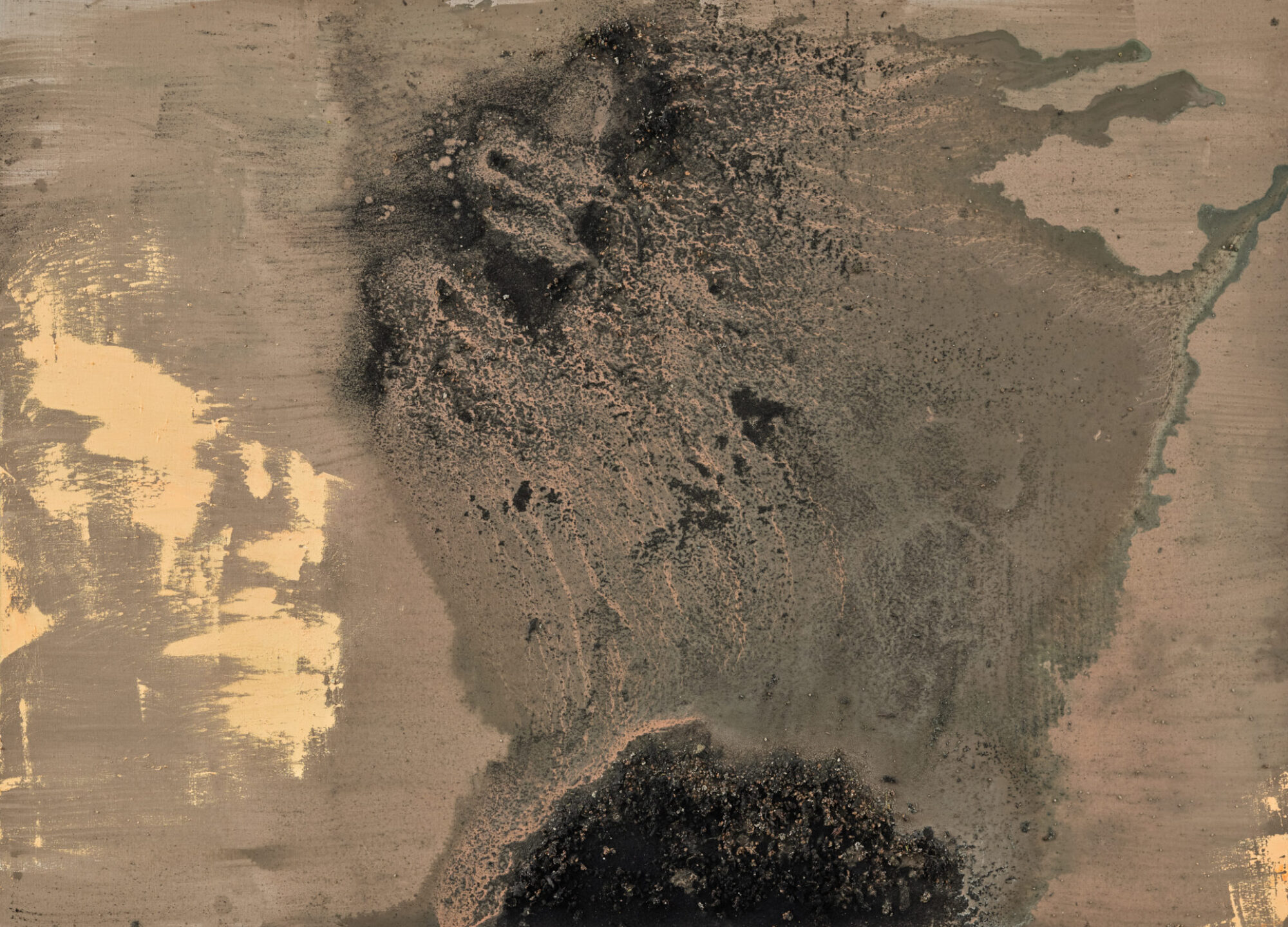“Tales about Colors / Berättelser om färger”
August 2021
“Green Rain” was begun and given a name in 2008 in New York, and completed in 2020.
The tale of this painting begins when I had to move out of my vast grotto-like studio in Red Hook, Brooklyn. In a last explosive gesture I painted Green Rain, rolled it up, affixed a label, and put the tube in storage, where it remained until the summer of 2018, when I unrolled it in my studio in Sörmland Sweden.
It was that foreboding extremely hot and dry summer three years ago when the word “rain” changed its meaning and weight for me. In this situation of uncanny coincidences, I started painting the top layer in oil. At that point the canvas had only received its first layer, which in my work process is done with the canvas on the floor, in a horizontal position, in water-based paint. This color is then explored, and step by step, the two layers become a visual language of form echoes, rhythms, spatial games. But the theme is there from the very start, in the color. In this case the theme is Green Rain. Why are these words joined? Rain is not green, but it is associated with greenery, the possibility of green. Yet, the color in the painting is not naturalistic at all. It is symbolic. To me the green of plants seems more a light phenomenon than a color, a certain kind of translucence. This absorption of light is also the very being of plants according to the French philosopher Emanuele Coccia. And rain is part of this “metaphysique of mixture”.
Some small paintings happen very fast in a forceful energy, and here I don’t have time to foresee which color or what light will emerge. The small round piece “The Bright Light from a New World”, 2021, is a such a painting. The title is an echo of my large painting from 1994, which hangs in the collection of Stockholm University. But today the title is reminiscent of affirmative thoughts in environmental activist circles: “another world is possible”. Yet, there is something threatening, annihilating and dramatic in the flaming light in the small painting. A paradox? Or how many catastrophes must we witness before we take the steps towards a new world? How do hope and despair cohabit in us?
“Tales from the Underground” was painted in 2006. The word “underground” stands here for something clandestine, an act that is carried out in quiet, through underground organization. In this case it is about something that took place on March 19, 2005, in midtown Manhattan, in the middle of the afternoon, which was not mentioned in the news even though representatives of the media showed up… NY Times, ABC News, etc.
A color can haunt me. When it has been hidden from view, as a repressed reality, it comes forth with all the more urgency, vivacity.
This recalls a particular sunny day in New York City when the fountain at Rockefeller Center was tinted red, and another day when black goo was spilled out at General Motors Plaza near Central Park. Footage from these events is part of the film “Berättelse” (“Tales”). The painting “Tales from the Underground” is a testament, a memorial to these colors; but here in the painting the colors are not at all realistic, but rather exalted. The black does not look like crude oil, but symbolizes it, and the red color is not bloodlike, but rather seductive.
A particular painting may have several different levels of underground. The word can designate that vertical depth that I have to descend into in order to mine color.
In the piece “June 4th, 2014”, the color turned out to be this deep red and brown. Like all my paintings it is made up of layers. But in this case the three layers constitute a particular story. The first layer stems from a performance in central Stockholm, on June 4th, 2014, the 25th anniversary of the massacre on Tiananmen Square in Beijing. With a large calligraphy brush I painted the Chinese characters for 6 and 4 and the Arabic numbers 1989 onto a large linen canvas spread out on the pavement. These characters are forbidden in China, must not be mentioned, the date does not exist.
Later in the studio the subsequent layers were applied; first pigment, medium and water, and then oil paint.
“Tales of Grey Gold”: the title designates a color or color palette that becomes a character, a player in a tale that is spun within the space of the painting. The idea and color palette called Grey Gold has been around in my life for a long time, it is a recurring theme, and yet… I still don’t know what or who Grey Gold is!
I hope that the title remains open to multiple interpretations, it could be a person in a tale, or a metal, a compound, a matter, or a dimension. In any case it is a color idea, the colorful gray, a color that tends to become mottled, grainy, black and white with nuggets of color. As though one is looking at something by zooming in on the material to discover its components.
I am often asked “How do you know when a painting is finished? Philip Guston, a New York painter who is important for many other painters, expressed himself thus: “The painting is ready when it has reached a state where it could continue, a state that is open. Otherwise it is dead like a wax museum.”
My paintings do not look like his but the statement fits me. Even though my end of process is more like a balancing act on a tightrope, I could in principle continue painting infinitely, but with smaller and smaller brushes and on more and more limited areas. I am polishing the border, the meeting point of layers, which is ultrathin. That which Marcel Duchamp called ”l’imperceptible, inframince”: barely perceptible and yet perceived. It is a thin, narrow (French: mince) portal, but it opens up the perspective into the depth of the painting.
The game stands between those layers in the painting. Let’s say there are two layers. Try to see them as one field, yet at the same time a coherent whole, like an image. This demands a certain focus, one that temporarily refrains from naming and interpreting.
In order for the painting to open up in three dimensions and in movement the viewer needs to focus on that small in-between where the layers meet. A focus not on the classical figure/ground relation which might first impose itself, but rather on that ultra-thin subtility.
Another example is the painting “Gold Camouflage”, 2010-2021.
Here the layers are related in the way that camouflage relates to the landscape it wants to blend into. I paint what I already see in the painting… it is yet again an ultrathin distinction in the layers.
Now why do I talk about layers?
Because layers offer a way to see, a possible way into the space of the painting. They offer literal steps.
When I tell you about this step into the painting, how one enters it by focusing on the layers, I tell you something about a property of the painting. This is an extra property, a nature it has beyond being a pleasant object on a wall in a room. And, furthermore, a property beyond its existence as a personally anchored tale in a poetic political life!
“Wallpaper for a Queen”, 2021. Imagine that you are sitting quietly gazing at superimposed layers in a patterned wallpaper. If you look in a certain way, slowing down the gaze so much that you no longer identify the shapes in the pattern, whatever they may be, birds, flowers… and instead see it as an abstract space, then the forms will start moving and changing. The phenomenon is inspiring. Here the imagination of the viewer can be projected in time: the shapes resolve themselves, for a moment, into figures and actions before they move on and shift like cloud formations. And why do I call this painting Wallpaper and why for a Queen? The color palette came to me in a dream one night. A couple of days later I chanced upon this exact color combination, rose and blue, in a 17th Century painting depicting an extravagant performance in Rome in honor of Queen Christina.
”18th Century Ceiling”, 2008. The title is a sort of invitation to the viewer: it says… You find yourself inside a building, a room with high ceiling. You look up towards the ceiling. It is a spatial situation that is offered, a perspective, an angle. You look straight up into this ceiling. Maybe it has peeling paint from ancient frescoes, maybe it looks like the vaulted sky, something you observe from afar. Here the imagination is literally given room to play, opening up a perspective in both time and space. When you look at something yet cannot estimate the distance or the scale, like clouds in the sky, well, then that spatial position invites daydreaming in the way of Gaston Bachelard.
When you arrange a snuggly corner for yourself, an interior, the physical place tends to become a subject like yourself. It looks back at you. This is precisely what I experience in the moment a painting is finished. The process up to that moment of precarious near-balance is long and complicated. It is as though the painting had to live through a story.
The most important thing in that work process is to discover the specific dynamic of the painting at hand. So that it can grow like a plant. The painting acquires the abstract qualities of a tale: a dynamic, light, mood.
Yet, at the same time there are also, as I described before, actual personal tales imbedded in the layers of the paintings. But I do not invent anything, I am just following leads. The first lead is always a color, a strong experience of color. It is an internal experience, whether this color originates from outer reality or a dream. Sometimes it can be a luminosity, as when an everyday object suddenly acquires an uncanny glow. Other times it is an intense inner perception associated with emotions bursting to come forth.
Form echoes and threads may be followed from one painting to the next and be woven together into further tales. Often I discover these threads afterwards with surprise.
A painting begins as a weave, a literal linen weave. But it also ends as a weave. A weave of light, to fix your gaze upon, an opportunity to project your own dreams, your underground as viewer.
Berättelser om färger
“Green Rain” påbörjad och namngiven 2008 i New York, avslutad 2020.
Berättelsen om målningen börjar då jag var tvungen att flytta ut ur min enorma grottliknande atelje i Red Hook, Brooklyn. I en sista explosiv gest målade jag Green Rain , rullade ihop den, satte på namnetikett, satte rullen i ett förråd där den förblev tills sommaren 2018 då jag rullade upp den i min atelje i Sörmland. Det var den illa förebådande extremt torra heta sommaren för tre år sedan då ordet Regn ändrade sin innebörd och tyngd för mig. I denna situation av kusliga sammanträffanden satt jag igång att måla skiktet i olja. Duken hade då bara det första skiktet, det som i min arbetsprocess utförs i vattenlöslig färg, horisontellt. Det som senare skall utforskas, för att stegvis utformas till visuellt språk, av formekon, rytm, rumsliga spel. Men hela ”temat” finns där redan från början i färgen. Alltså i detta fall, temat Green Rain. Hur hänger de orden ihop? Regn är inte grönt, men det förknippas med grönska, möjligheten till grönska, till grönt. Samtidigt är färgen i målningen inte alls naturlig. Den föreställer inte grönska. Den är symbolisk. För mig ter sig växters grönska som ett ljusfenomen mer än en färg, en viss sorts genomlysthet. Denna ljusupptagning också är växternas vara enligt Emanuele Coccia i The Life of Plants. Regn är en del av denna ”blandningens metafysik.”
En del små målningar kommer till blixtsnabbt i våldsam energi, och här hinner jag inte ha en aning om vilken färg eller vilket ljus som skall uppstå. Lilla runda ”The Bright Light of a New World ”, 2021 är en sådan.
Titeln är ett eko från min stora målning från 1994 som hänger i Stockholms universitets samling. Men idag 2021 påminner titeln om affirmativa tankar i miljöaktivistiska kretsar…”another world is possible”. Samtidigt finns något hotfullt, förgörande och dramatiskt i det flammande ljuset i målningen. Paradox? Hur många katastrofer måste vi bevittna, och när tar vi stegen mot en ny värld? Hur förena förtvivlan och hopp?
Tales from the Underground målades 2006 . Ordet ”underground” står här för något som är fördolt, som sker illegalt, i tysthet, genom underjordisk organisation. I detta fallet handlar det om något som ägde rum 19 mars 2005, mitt i New York City, mitt på blanka eftermiddagen, men som inte nämndes av media, trots att de var på plats, NYTimes, ABC news m.fl.
En färg kan pocka på min uppmärksamhet, för att den mörkats i verkligheten, och därför framträder ännu starkare i min fantasi. Som minnet av denna dag i New York, då fontänen vid Rockefeller Center färgades röd, och sedan en annan händelse, då svart geggamoja hälldes ut vid General Motors Plaza. Video från dessa gatuaktioner ingår i filmen “berättelser”.
Färgerna förevigades i målningen Tales from the Underground, men här blir de inte alls realistiska, snarare exalterade. Den svarta sörjan liknar inte tjockolja utan symboliserar den, och den röda färgen här är inte alls blodlik, snarare förförisk.
En och samma målning kan även ha olika nivåer av underjord. Och ordet kan också stå för det vertikala djup jag måste ner i för att få fram färg.
I målningen ”June 4th, 2014”, visade sig färgen bli djupt röd och rödbrun.
Liksom alla mina målningar är denna målad i lager.
Men här utgör de tre lagren stegen i en speciell berättelse. Det första lagret kom till under en performance på Stureplan i Stockholm den 4 juni, 2014 på 25årsdagen av massakern på Himmelska Fridens Torg i Peking. Med en stor kalligrafipensel målade jag de kinesiska tecknen för 6 och 4 , och siffrorna 1989 på en linneduk utspridd på gatstenen. Förbjudna tecken i Kina, datumet finns inte , får inte nämnas.
Senare i ateljen tillkom de följande lagren av först pigment och medium, sedan oljefärg.
”Tales of Grey Gold”: titeln anger en färg eller färgpalett som blir en karaktär, en spelare, i berättelser som spinns inom målningens rum. Ideen och färgpaletten Grey Gold har hängt med länge, det är ett tema som återkommer då och då i mitt liv, och ändå vet jag fortfarande inte vem eller vad Grey Gold är! Min förhoppning är att titeln skall förbli öppen för tolkning. Grey Gold kan tänkas vara namn på en person i en berättelse, eller också en metall, ett ämne, en materia, en dimension. I varje fall är det en färgide, det kulörta grå, en färg som tenderar att bli spräcklig, skrovlig, svart-vit grå med inslag av färg. Som om man hade zoomat in på en materia och upptäckt beståndsdelarna.
Jag får ofta frågan Hur vet du när en målning är färdig? Philip Guston , en New York målare som betytt mycket för andra målare, sa så här: “Målningen är färdig när den nått ett tillstånd där den skulle kunna fortsätta, ett tillstånd som är öppet. Annars är det dött som ett vaxkabinett.”
Mina målningar liknar inte alls hans men påståendet stämmer för mig. Även om slutet för mig är mer en balansakt som på styv lina, så skulle jag i princip Jag skulle kunna fortsätta i det oändliga på en målning, dock med mindre och mindre penslar och på begränsade ytor. Jag filar på mötet mellan lagren, som är ultratunt, ”l’imperceptible, inframince” som Marcel Duchamp kallade det: nätt och jämnt förnimbart men som ändå urskiljs.
Det är en smal ( på franska mince) portal men den öppnar perspektivet till målningens djup.
Spelet står mellan de där lagren i målningen.
Låt oss säga att det är två lager. Försök se dem som ett fält, som 1 och 2. Och samtidigt se det hela som sammanhängande, som en bild. Det kräver ett visst sort fokus, och att man tillfälligt avstår från läsning och tolkning. För att målningen skall öppna sig i tredimensionalitet och rörelse behöver betraktaren fokusera på det där lilla mellanrummet. Där lagren möts. Och inte på den figur – grund relation som först kanske träder fram, utan i stället den ovan nämnda infra-tunna subtiliteten.
Ett annat exempel är målningen “ Gold Camouflage ”, 2010 -2021 Här förhåller sig lagren till varandra såsom kamuflagemålning förhåller sig till landskapet det vill smälta in i. Jag målar det jag redan ser i målningen, det blir återigen en ultratunn skillnad i lagren.
Varför talar jag nu om lager?
Därför att det är ett sätt att se, som utgör en möjlig väg in i målningens rum. Det är bokstavligen steg.
När jag berättar om det steget in i målningen, hur man tar sig dit genom att fokusera på de två lagren berättar jag något om målningens beskaffenhet. Den extra beskaffenhet som den har utöver att vara ett behagfullt objekt i ett rum på en vägg. Och till och med utöver dess vara som personligt förankrad berättelse i ett poetiskt-politiskt liv!
“Wallpaper for a Queen”, 2021. Tänk dig att du stilla sitter och blickar på de tryckta lagren i mönstret på en tapet. Om man tittar på ett speciellt sätt, saktar ner blicken så pass mycket att man inte längre identifierar formerna I mönstret, vad de nu kan vara, fåglar eller blommor osv och istället ser det som en abstrakt rumslighet så uppstår rörelse och förändring i formerna. Det fenomenet inspirerar. Här kan betraktarens fantasi projiceras så att formerna blir figurer och handlingar för ett ögonblick innan de fortsätter att röra sig vidare likt molnformationer. Och varför kallar jag den “Wallpaper for a Queen”? Den rosa och blå färgpaletten till målningen kom till mig i en nattlig dröm. Några dagar senare stöter jag på exakt den färgkombinationen, rosa och blå i en 16tals målning föreställande ett skådespel i Rom till Drottning Kristinas ära.
”18th Century Ceiling”, 2008. Titeln är en sorts inbjudan till betraktaren, den säger… Du befinner dig i en byggnad, ett rum med mycket högt i tak. Du tittar upp i taket. Det är en rumslig situation som erbjuds, ett perspektiv, en vinkel. Du tittar rakt upp i taket. Kanske har det flagnande färg från forna fresker, kanske liknar det ett himlavalv, något man spejar på , på långt håll. Här kan fantasin bokstavligen få ett spelrum, som öppnar perspektiv både i rummet och i tiden. När man tittar på någonting som man inte kan bedöma avstånd till, eller som saknar skala, exempelvis moln på himlen, så inbjuder den positionen till drömmeri i Gaston Bachelards anda.
När man skapar en vrå åt sig själv, en interiör så är det som om den fysiska platsen blir ett subjekt liksom en själv. Det tittar tillbaka på en. Det är precis så det förefaller mig i ögonblicket när en målning är avslutad. Processen fram till detta tillstånd av balans på styva linan, är ofta komplicerad och utdragen. Det är som om målningen genomgår en berättelse.
Det viktigaste i arbetsprocessen är att komma underfund med den pågående målningens specifika dynamik. Så att den kan växa fram likt en planta. Målningen får en berättelses abstrakta egenskaper såsom dynamik, ljus, stämning.
Samtidigt finns det ju, som jag beskrivit ovan, även faktiska och personliga berättelser inbäddade bland lagren i målningarna.Men jag hittar inte på någonting, bara följer ledtrådar. Den första ledtråden är alltid en färg, starkt upplevd i det inre, vare sig den härstammar från något yttre verkligt eller från en dröm. Ibland kan det vara ett skimmer, som när ett vardagligt föremål plötsligt framstår i en besynnerlig dager. Det kan också vara en intensiv inre förnimmelse förknippad med känslor som bemödar sig att komma fram.
Formekon och trådar kan följas från målning till målning och vävas samman till ytterligare berättelser. Jag upptäcker själv ofta med förvåning dessa trådar i efterskott.
En målning börjar som en väv, bokstavligen, en linneväv. Men den slutar också som en väv. En väv av ljus att fästa blicken på, en möjlighet för att projicera egna drömmar, betraktarens egen underjord.
Madeleine Hatz
August/Augusti 2021
“Konstens frågeformulär #119: Madeleine Hatz”
Magnus Bons, redaktör/editor, Konstens frågeformulär #1-132/
Questionnaire from Konsten Magazine #1-132 (Konsten förlag, 2020)

# 119: Madeleine Hatz
Beskriv din konst med tre ord: Måla, tänka, agera.
Hur ser din arbetsprocess ut? Mitt arbete som konstnär inbegriper både måleri och aktivism, text och performance. Alltså både solitärt ateljéarbete och utåtriktat socialt arbete, framträdanden, samtal, spontana gatuaktioner. De olika aktiviteterna korsbefruktar varann. Känslor alstrar energi, blir bränsle.
Måleriet tar mycket tid. Det är det huvudsakliga, både grund och slutgiltigt verk. Jag kan inte alltid måla. Det kräver vissa omständigheter.
För att måla måste jag först komma till en nollpunkt. Ta bort allt ovidkommande. Distraktioner. Sedan måste allt vara på plats. Det är typ 90 procent förberedelse och 10 procent handling. Rummet där det skall ske är viktigt. Det måste ha minst ett tydligt hörn som är helt tomt. Jag måste först vara därinne, med stängd dörr och i tystnad. Det kan ta några dagar. Sedan kommer färgen. Det börjar alltid med färgen. Jag ser den. Den kan ha uppenbarat sig i mat, material eller ett föremål dessförinnan, något alldagligt som plötsligt får en märklig lyster. Exempel: En dollarsedel man drar fram ur plånboken. Ledde till målningar under flera år.
Djup melankoli, avgrunder av fruktansvärd förtvivlan, mörker, paralyserande smärta och depression är stundom ett förstadium till mitt måleri. Speciellt innan ett riktigt stort verk, någonting helt nytt. Både i livet och måleriet faktiskt.
När jag målar hittar jag inte på något. Jag följer så noggrant som möjligt den dynamik som finns i målningen.
Vad inspireras du av? Ensamhet och Samhörighet: Upplevelsen av att vara riktigt vaken i dessa båda omständigheter. I ensamheten riktigt förankrad i min kropp, så att perspektivet kommer djupt inifrån och riktar sig utåt i en tydlig mätbar orientering utåt i rymden. Upplevelsen av rymd/rum i arkitektur är mycket inspirerande, t ex mörkret och de böljande mosaikgolven i Markuskyrkan i Venedig. Samhörighet: Den euforiska upplevelsen av ”incandescent intimacy” som kanadensiske filosofen Erik Bordeleau skriver om. Han beskriver den intensiva mystiska känslan av samhörighet med främlingar när man gemensamt intar gaturummet i politiska aktioner.
Samhörigheten kan också vara kontakt med tidigare historiska skeden och personer, skapande själar som den helige Franciskus, Hildegaard von Bingen, Gurdieff, anonyma medeltida mästare. Kontakt uppstår genom att man sätter sig in i deras verk och liv.
Läsning är inspirerande: Clarice Lispector (hon påverkar alltid mina drömmar), Bachelard ( om rumslighet), Henri Corbin (sufistisk mystik), Maurice Blanchot (”en konstnär får ordning i sitt eget kaos genom att kliva in i det”), kinesisk daoistisk poesi, The Mustardseed Garden Manual of Painting (om hur man målar en sten t ex), Jurgis Balthrusaitis texter om ”det fantastiska”, George Monbiot !( journalist och aktivist, The Guardian).
Vilka bilder har du omkring dig där du jobbar? Inga. Viktigt att ha stora vita väggytor.
Vilken annan konstnär har varit viktig för dig? Många. Min far Felix. Såg på konst från 3 års ålder. I New York, många samtida omkring en, t ex Saint Clair Cemin som jag delade atelje med och otaliga andra vars suveränitet man inspireras av t ex Sue Williams, Louise Bourgeois, Carl Ostendarp. Och konsthistorien: Dosso Dossi, Joakim Patinier, Ribera! Klein, Burri, kinesiskt landskapsmåleri, medeltida altarskåp. Långa värdefulla dagar på Metropolitan Museum i New York.
Vilket konstverk önskar du att du gjort själv? En Paul Klee kanske. Ser ut som barnlek men är extremt bemästrat.Teckning av samtida Billy Lynch. Performance av Francis Alys eller Marina Abramovic.
Vad är konst till för? Det omöjliga. Att få kontakt med anden.Att inspirera. Gatuaktioner vill inspirera andra. Marin Marais i filmen ”Tous les matins du monde”, svarade på frågan om vad musik är till för: få kontakt med den älskade avlidna. Och Philip Guston sa: ”I just want to be in that state.”
Vad är konst inte till för? Marknaden.
Vilken åtgärd skulle främja konsten? Totalt paradigmskifte från mördande konsumism till uppvaknande, liv och djupt samspel med jorden.
https://www.madeleinehatz.com/Madeleine Hatz’ senaste utställning var ”Sånger från underjorden 2” på Vida konsthall på Öland, april -juni 2019. ”Sånger från Underjorden” visades i Salarna på Konstakademien och på Galleri Olsson oktober-november 2017.
“Clouds”
Text accompanying paintings “Vanilla Cloud” and “Grey Gold Ceiling” at exhibition “Clouds,” Museum of Sketches, Lund, 2012. Curator: Elisabeth Haglund
Today I think about clouds.
My mother told me that as a baby I would be laying in a pram outdoors. I would spend hours looking straight up at the passing clouds and laugh. That perspective has followed me throughout life: looking straight up at a perpendicular angle laying upon the ground, or looking straight down at the crust of the earth from a horizontal hovering position. These are positions without gravity and without scale. Clouds are always changing; they grow and they shrink. At the same time there is no reference to indicate a measure of large or small.
According to ancient Chinese thinking, “the small has no inside” and “the large has no outside.” Consequently it becomes meaningless to scientifically explore every smaller unities, atoms, neutrinos etc. There is always an even smaller unit, as “the small” has no inside. Small and large are movements, expansions. Seen from space clouds are a art of the crust of the earth, a part of the water of the seas becoming steam that swirls over the surface of the earth. It is in these regions that Painting operates. In between the material and the immaterial. The needs of my body and soul become ever simpler. Painting links together earth, body, food, and paint. All is dust and pigment, and it is the story of the direct relationship to the earth.
Moln.
Idag tänker jag på moln.
Min mamma har berättat att jag som spädbarn brukade ligga i en vagn utomhus. Jag låg i timmar och tittade rakt upp i himlen på moln som drog förbi och skrattade ett kluckande skratt.
Det perspektivet, att se rakt upp i rät vinkel, liggade raklång på marken eller att se i horisontell ställning, svävande, rakt ner på jordskorpan, har sedan följt mig genom livet. Det är en position utan tyngdlag och utan skala. Moln är i ständig förändring, de växer, de krymper. Samtidigt finns här inget mått som kan ange stort eller litet. I kinesiskt tänkande heter det Det lilla har ingen insida , det stora har ingen utsida. Enligt det tankesättet blur det meningslöst att vetenskapligt söka utforska mindre och mindre enheter, såsom atomer, neutriner etc. Det finns alltid någonting mindre för det lilla har ingen insida. Litet och stort är rörelser, expansion.
Sett utrifrån rymden är molnen en del av jordskorpan, en del av havets vatten som blir ånga och virvlar runt over jordens yta.
I dessa trakter rör sig måleriet. Mitt imellan det materiella och det imateriellla. Min kropp och själs behov blir allt enklare. Måleriet länkar samman jord , kropp, mat och färg. Allt är stoff och pigment, och handlar om en direkt relation till jorden.
Madeleine Hatz
Beijing, March 2012
“Necessary Recklessness”
Divan: Journal for Psychoanalysis and Culture 3-4, 2008
I may well look like a well behaved girl, thrifty and orderly….but once I step into the studio there is unbridled spilling, boundless trashing, and wasting of gallons of materials. Fine clothing gets ruined, expensive ingredients disappear into unidentifiable mixtures. Often when I leave the studio after concentrated work, I discover inexplicable bruises on my body.
In art there is no room for consideration for one’s comfort, no consideration…
for the place
for the time
for the surroundings and its dwellers
for decency
for security
The “space” of concentration, which the studio constitutes in a mental sense (Blanchot would call it “l’espace litteraire”) is actually more a moment than a place. Certain acts need to be executed terribly fast, at the breaking point, in the tension between frustration, reticence and… act. This type of event can only take place in the right instance, after deliberate and careful preparations, and yet in a sort of extreme clumsiness, recklessness.
The notions of care and consideration mark the feminine, the daily “work of woman”. It is my nature, it resides in my spine and reaches out into my fingertips. It is my femininity, my sensuality and ultimately my energy. Paradoxically the combination of these two extremes is what I need:
Excessive care and its opposite, brutal recklessness.
Edward Munch talked about being disturbed by surrounding family and people who demanded “so much consideration”, which was devastating for his painting practice. He treated his own canvases with total brutality, exposing them to the elements and to trampling feet. He claimed that the paintings thus acquired “character”. But does this really show in the paintings, or is this something that is necessary for the relationship between the artist and his work? What is it that unconditionally demands recklessness? The demand comes from the poetic work itself. Kafka states that writing comes as a reward, as payment for having served diabolical forces. Blanchot talks about Kafka’s faithfulness to what he terms “the demands of the work”.[i] The work that Blanchot describes in “L’Espace litteraire” is the poetic work, and thus it is art as well as literature.
What is it then that happens in the mental and physical space of mine, where acts often are executed in a flash and without consideration of decency. The answer lies in the connection between the space and the act. It is as though the space became an act, and transversely as though the act was a space. In other words, it is a situation.[ii] In a general sense, a situation is the placing of a subject, an acting individual in a place under certain premises. For me these premises are all the preparations, gathering of materials and information, and arranging them in the studio space. The recklessness consists in the total concentration on that exact moment, in time and space that this situation constitutes. From this point I have a perspective, an angle of vision and a possibility of action. A perspective is precisely this: an axis along which the field of vision can be organized. To paint for me is to succeed in localizing myself in such a manner that I become a point of absolute stillness, so that everything else is put in motion in relation to this point. It is as though the perspective is reversed and I am placed myself at the vanishing point. In this way the visible can pass through me and movement can occur. A natural gravitation field is thereby provided for thoughts, feelings, and perception of the time we live in. How can this situation be achieved?
I have learned what influences me: discipline, geometry/architecture, ritual. Ritual and discipline are connected to controlled violence and controlled tempo (violent speed, extreme stillness). Geometry/ architecture are a structuring that relate to the physical space. The necessary recklessness can also be termed a necessary boundlessness: the point is to achieve a situation of boundlessness. From this place a genuine relation to the time we live in can be reached. If art is to be a mirror of contemporaneity (and/or a game played with it), then consideration of esthetics, taste and decency constitute a hindrance for truth. If at the end of the day in the studio, one looks back and confronts the view of something amazingly “beautiful”, it is clear that this has happened in spite of all and by paradox. It is most mandatory to give up all consideration of end result when working, only thus can results be achieved. Instead one is focused on the moment in the space when time disappears and the act executes itself.
In legal contexts, the term “recklessness” describes the mental state an individual is in when committing criminal acts: there is no reckoning of the consequences. To have the courage at all to be an artist, it might help not to “reckon”. The alternative spelling “wrecklessness” alludes to direct destruction (as in ship wreck).
Acts of great courage, protest actions carried out in climate of repression, for example home-made fake crude oil spilled out on a sidewalk, fountains turning blood red….such things require recklessness in relation to one’s safety and comfort. In the end everything in art, as in life is paradoxical. Things, works of art are created through destruction. The explosive simultaneously contains stillness. The most grandiose and magnificent chaos is preceded by careful calculations and planning. The thoughts of the absent-minded professor are not scattered but on the contrary the professor is absorbed by a focused train of thought. The inconsiderate artist is considering only one thing which for the moment absorbs all consideration. The reckless woman spilling out a whole barrel of paint on the white floor is taking care of ONE, one exact moment, one precise act, will, vision.
Madeleine Hatz
New York, October 2008
[i] Maurice Blanchot, The Space of Literature (Lincoln: University of Nebraska Press, 1982) p. 52, p. 73f.
[ii] Madeleine Hatz, “The Work Process as Spatial Situation: A Sketch,” International Forum of Psychoanalysis 9 (Oslo: Scandinavian University Press, 2000), p. 93-96.
“Den nödvändiga hänsynlösheten”
Divan: Tidskrift för kultur och psykoanalys 3-4, 2008, p. 122-125
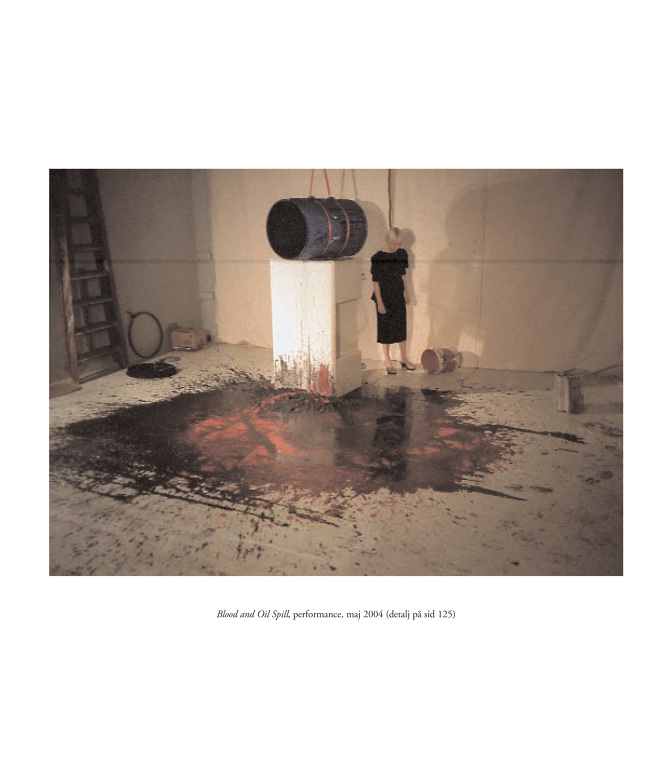
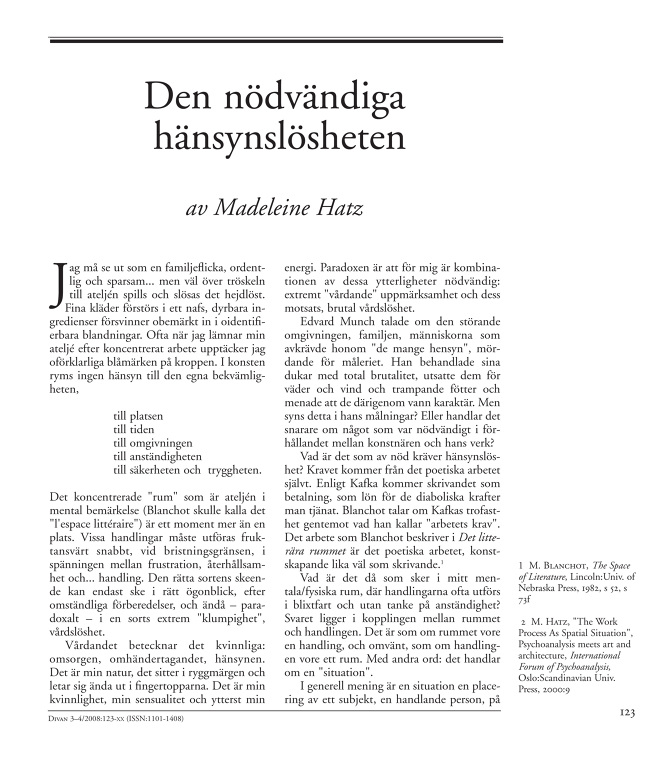
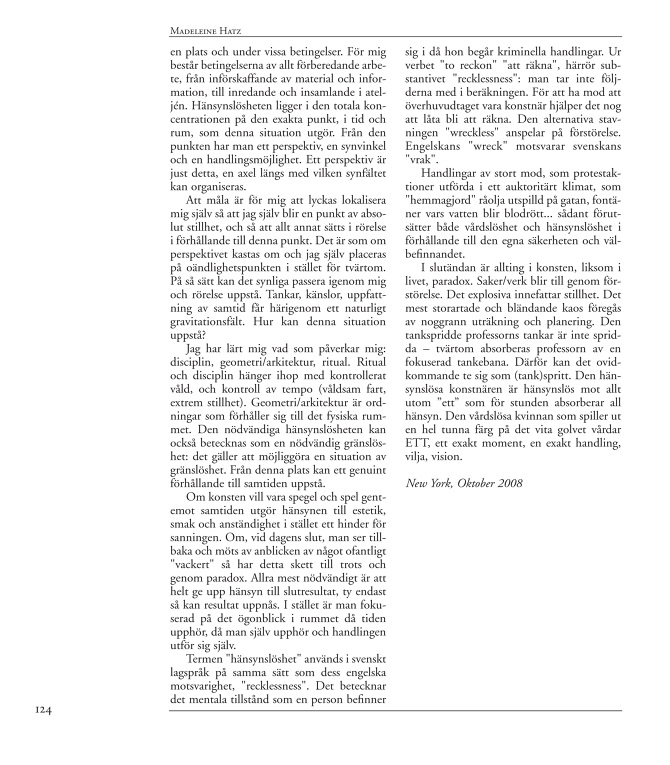
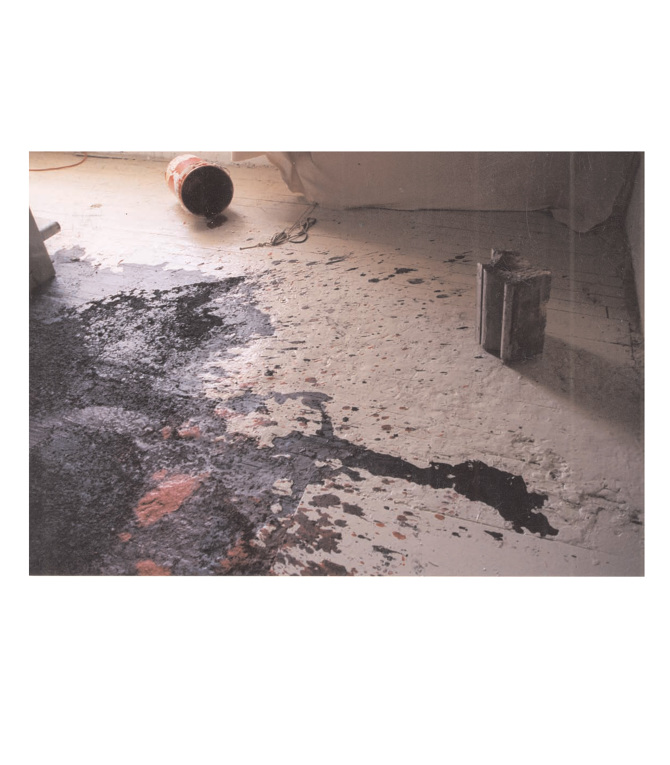
“Blue Orange Manifesto”
October 18 2002
In the days after September 11, we New Yorkers united in commonhood: Strangers in the streets offered each other compassion.
The strange odor (of burnt plastic? cremated bodies?) which is still in the air here, is associated with a sense of horror and foreboding. We have experienced the horror, the fear, the loss, from up close. When we now see news pictures of Afghan villages and cities being bombed, we know the tremors, we know the piles of rubble, the smoke, the smell of death.
Let us extend our compassion to all people!
Otherwise how can we use the word compassion?
Love thy neighbor??? Or would that mean only your next-door neighbor?
In the year 2002, the term “neighbor” ought to mean your “fellow human being”!
I believe there is no “us” and “them”. There is only “us”. All of us – little humans.
As humans we are standing at a crossroads in History. There have never before been so many weapons with the power to totally annihilate the world, and they are in so many different parts of the world.
Communications have never traveled faster, and technological development and consumption rates as well as pollution and environmental destruction have never accelerated faster. At this crossroads, we must take the road of survival.
Let us “stand united” against the threat of global destruction and for global survival!
Many voices, in different parts of the world, are now speaking of this moment as an opportunity for radical change that can lead to an ultimately more stable world. We do not have security now due to the threat of terrorist acts, and terrorists operate internationally, encouraged by a world based on nations and borders. In a global community, with global laws, we could go after criminals more effectively. We have to make agreements across the board of how we define “terrorist” and “terrorism”.
We will need new common definitions, new thinking, a new sense of identity. Finally, compassion as a notion is not purely emotional. It can be seen as a conscious and mental effort.
In a time of crisis, many people reach for something to hold on to: values we learned and that bring us together as a community. Maybe this explains the enormous proliferation of American flags now around the city. Even though, in many places on the globe, the American flag symbolizes military superpower, bombs and devastation, I realize that to quite a few New Yorkers, the flag means cohabitating cultures and ethnicities.
It is time to ponder the meaning of the word “community”, and search for a new way of being in the world. In a church in Holland a year ago I painted a Sufi quote on the wall, in an arch over a lamentation scene (also my me). The inscription reads: “Be in the world like a stranger, a passerby.” It is a position of humility rather than of pride, yet if you are a stranger everywhere, you also belong anywhere, temporarily. This is a paradox, something that is seemingly an incompatibility. What is mystery becomes very clear and simple on an ethical level: Love Thy Neighbor as Thyself.
Personally I see it as my role, to pray to the “gods” of others. Thus my Blue Orange Works become a prayer. God help us all!
All religions I know share (at least on a theoretical level) the values of compassion, mercy, brotherhood (social responsibility) love and peace.
American people (up to 95%), according to a recent study, see themselves as religious.
“In the name of Allah, the merciful and the compassionate…” Thus starts the Koran.
On a practical, political level, the logical conclusion of all the above spells out:
Stop the bombing, start negotiating. Let’s work for survival, united against the threat of global devastation. Let’s take responsibility for and begin to take care of our earthly community and environment, to share our wealth, resources and territory.
“The Work Process as Spatial Situation: A Sketch”
International Forum of Psychoanalysis 9, 2000, p. 93-96
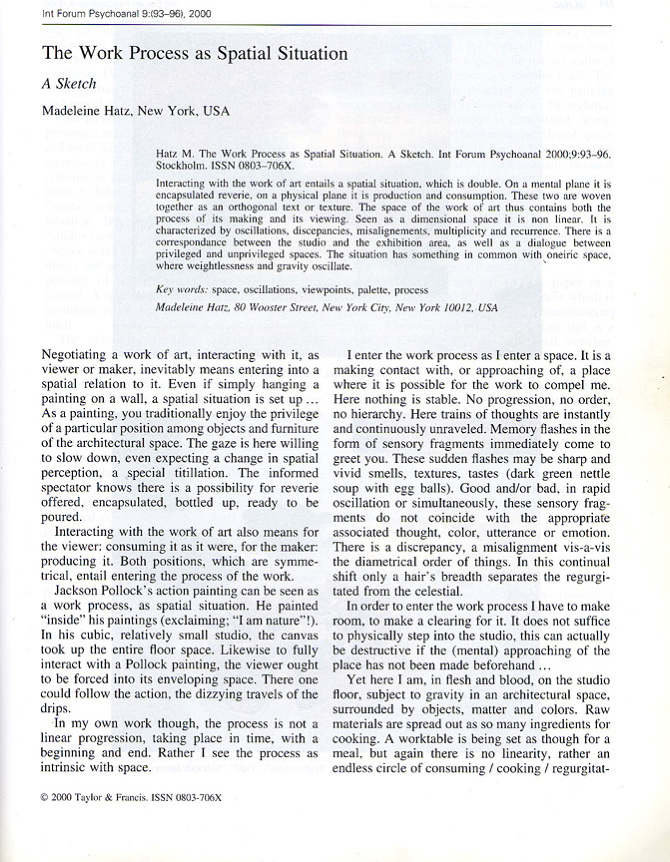
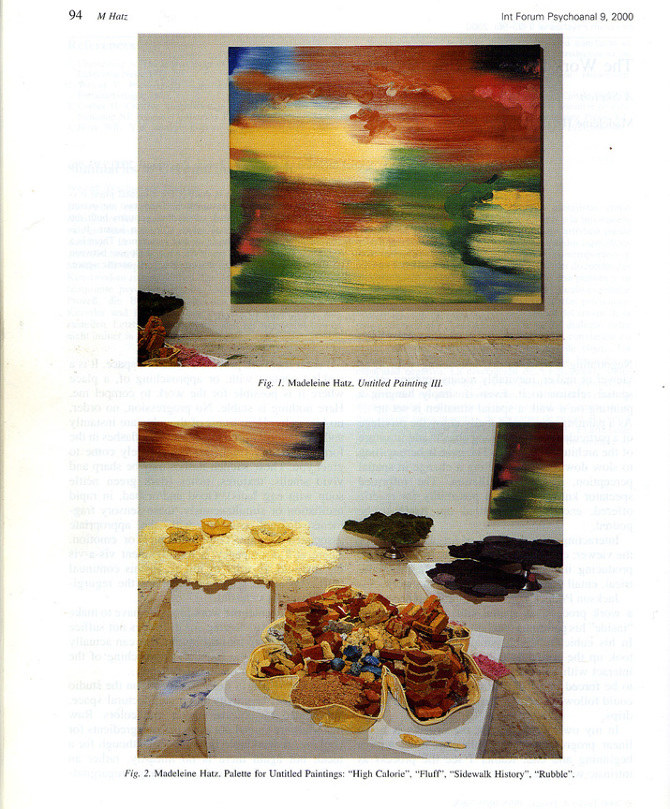
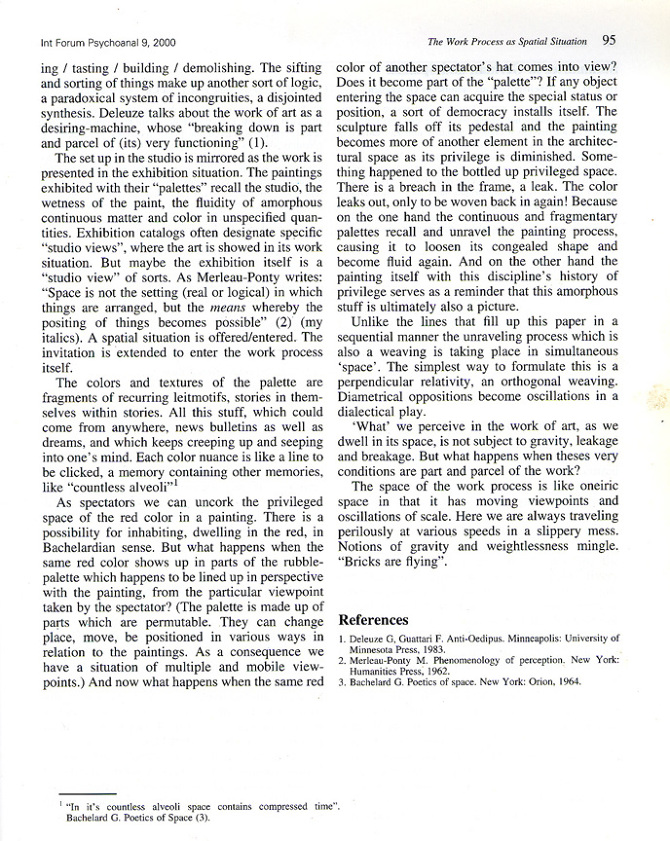
“June Unnatural”
1988 catalog text for exhibition “Unnatural Selection: The Transformation of Nature in Abstraction”, Raritan Valley Community College, Raritan New Jersey. Curator: Tom McGlynn
At my landing door: a monstrous plant with gigantic green leaves is slowly spreading, taking up all the space, threatening to close off window and door. Inside the studio, on the floor: green foam particles spilled out from plastic bags, This fluffy stuff is manufactured in different grades, so as to imitate early spring growth or distant forest. In the living area: many green plants give comfort. Around the cooking island, laid out as precious objects: tomatoes, fruits, foods. On the sideboard where the food “should” be: my manufactured pigmented fragments with drippings. Next to them in color coordination: an “abstract” painting on the wall. And, nearby, the computer’s screen saver: Mandelbrot’s (abstract?) fractals are growing like green ferns, flowing in the room, echoing the flamboyant Rocaille/Chi cloud motifs in the painting. And to sum up my living situation among objects: the TV set died last week, now it just gives off a green glow.
The fine line between one green and the other, the “green” and its other… is like the hair’s breadth barely separating celestial from profane, transcended from regurgitated.
Because, it may well be that the diametrical opposition as such is an illusion, and the real situation then being rather a perpendicular relativity, an orthogonal weaving.
I don’t know what time is, but I know, or rather: I experience, situations which are not linear or diametrical. Smells for instance, sudden memory flashes of smells (good or bad) often do not coincide with the appropriate associated thought, color, utterance, or emotion. When in a state of intense concentration (like when painting), they can be isolated breaks, taken out of context, abstracted yet so totally vivid and real. Here something seems extracted from linear time, and placed at a different angle to it. There is a discrepancy, a lag in the codes, so that the sensory fragment is in misalignment with the “order” of things, desired, abject, natural, unnatural, supernatural.
Madeleine Hatz
New York, June 1998
